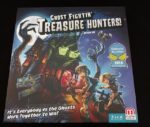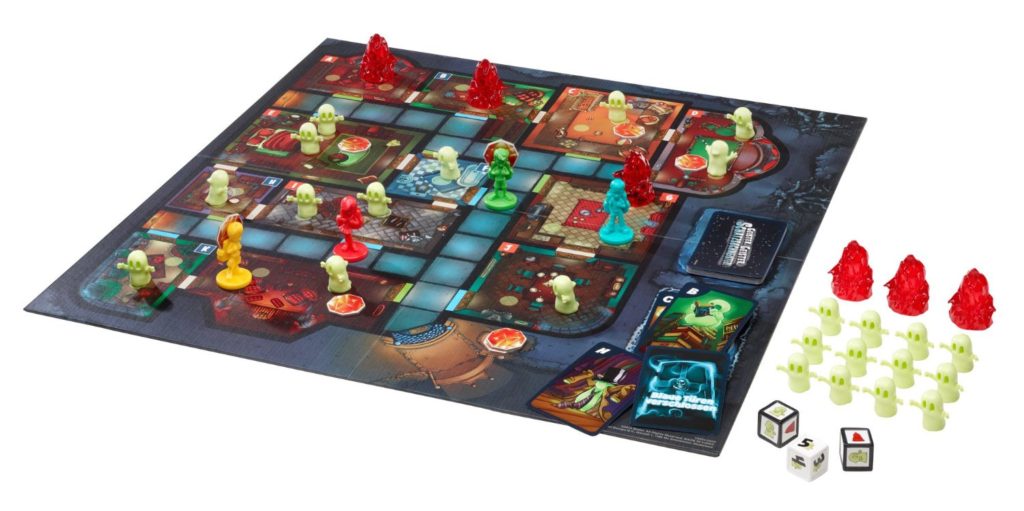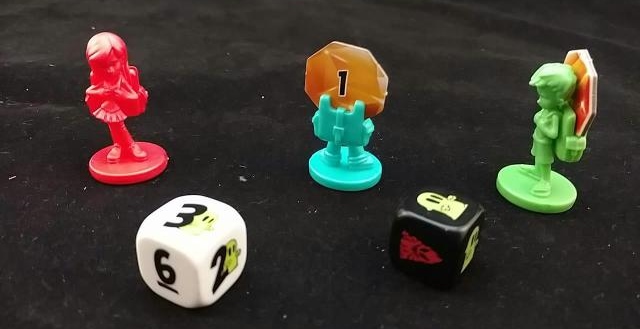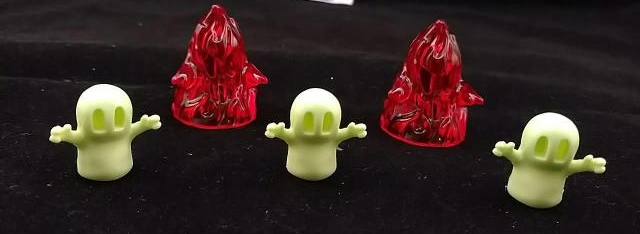Unplugged: Ghost Fightin’ Treasure Hunters (Boardgame)
 In the past decade, the idea of cooperative boardgames, where everyone wins or loses as a team, has blossomed. As dad of young boys, I enjoy playing games together where we can all be on the same side. In Ghost Fightin’ Treasure Hunters!, players move through a haunted mansion to collect all the Treasure Jewels and escape the house before it is overtaken with ghosts. It is that rarely-seen gem of a game that can be enjoyed by kids or adults.
In the past decade, the idea of cooperative boardgames, where everyone wins or loses as a team, has blossomed. As dad of young boys, I enjoy playing games together where we can all be on the same side. In Ghost Fightin’ Treasure Hunters!, players move through a haunted mansion to collect all the Treasure Jewels and escape the house before it is overtaken with ghosts. It is that rarely-seen gem of a game that can be enjoyed by kids or adults.
Ghost Fightin’ Treasure Hunters
Publisher: Mattel Games
Ages: 8+
Players: 2-4
Time: 30 mins
(Review copy provided by Mattel Games)
The game begins with the house stocked with four ghosts and eight gems. Players venture into the house to pick up gems and bring them out the door. However, there are two main problems to solve. First, players can only carry one gem at a time (the player figures even have a little backpack slot to carry them.) Second, almost every turn another ghost is added to the house.

Anyone familiar with the game of Clue will feel comfortable with the haunted house. Twelve rooms are connected to each other and via longer hallways. Players start their turn by rolling the movement die, and may then move up to the number shown on the dice. In addition, on every face but “6”, a ghost figure appears next to the number. When a ghost is showing on the die, a card is flipped up from the deck and a ghost is added to the room indicated on the card. If there are already two ghosts in that room, the happy little green ghosts are removed and replaced with a nasty red haunt figure. As more and more ghosts appear, haunts become more likely. If the board ever contains all six haunt figures, the game immediately ends in a loss.

If you choose to end your turn in a room with a Jewel, you may pick it up. If you end your turn in a room with a ghost (or haunt), you must fight it. To fight ghosts, roll the fighting die. If a green ghost face (found on 4 sides) appears, one ghost is removed from the board. If there are two players in the same room (because the previous player was already there), they can both roll a fighting die, increasing their chances of eliminating one, or even two, ghosts. Haunts are particularly bad. They trap players carrying treasures, preventing their movement. In addition, they can only be fought by two players at once. They are eliminated if one of the players rolls a haunt face (found on 2 of the sides.)
Play continues with players rolling and moving about the board, adding ghosts and haunts when showing on the die. Almost every roll (except a 6) will add a ghost so players need to be eliminating a ghost almost every turn. Gameplay gets more and more hectic as ghosts and haunts appear, with most games ending in a few last, suspenseful turns.
In addition to the basic game described, there is an additional “advanced game”, which makes things a bit more difficult but doesn’t add too much more to its complexity. The ghost deck always has one card which, when revealed, does not add a ghost but causes the deck to be reshuffled. This keeps things uncertain, since players can’t simply count cards to know for sure where the next ghost will appear. In the advanced game, six new cards are added to the deck. Two of them will reshuffle the deck, but they also force players to draw extra cards that turn – flipping up two or even three ghosts instead of just one. The other four cards represent blue or green doors. The doorways on the board are color coded in green and blue. When a colored card is displayed, all doors of that color are locked and cannot be used until a different color door is drawn (thus locking a different color) or the deck is reshuffled (when all door cards are also shuffled back into the deck.) Finally, the gems are all numbered on one side. Starting with the gems’ numbers face down, players must enter the house and bring back all the gems in numerical order. I have found adding the new ghost cards to the deck makes the game a bit more interesting but doesn’t greatly increase difficulty. However, requiring the gems to be removed in numerical order significantly increases the challenge.
Verdict:
With a clever theme, and a nicely rendered house (and happy little ghosts), Ghost Fightin’ Treasure Hunters! is a welcome addition to the world of cooperative games. It is simple enough to play with a wide range of ages, but there is room for good strategic play. The randomness of the dice and ghost cards allow for surprise ups and downs, adding piquant to the story of the game. In particular, adding in all the advanced options makes the game challenging enough even for grown-ups to celebrate their wins.

Kid Factor:
The game does not even require any reading (other than the alphabet for the ghost cards), so it is playable by any child who will not be tempted to eat the dice or ghost figures. However, when playing with the very young you may have to work a bit harder to win with the addition of their random whims. Older gamers, such as tweens, will appreciate the advanced rules and get to enjoy a more tightly fought contest that typically will go right down to the wire. By offering both a beginner and an advanced game, Ghost Fightin’ Treasure Hunters! offers up a great gaming experience for young kids as well as adults. Play the game now when your kids are young, and you can still be playing it years later even after they’ve grown.
*Note: A new, more mass-market version of the game will be coming out in the future, tied in with the release of the new Ghostbusters movie. While that one will have a more recognizable name, theme, and a slightly lower price point, it will also have a smaller board and figures and won’t have quite as high quality of components. Since this is a game that should last for a long time, I’d recommend going for the Ghost Fightin’ Treasure Hunters! version unless you really have to have the Ghostbusters name.
(Images from the review at www.OpinionatedGamers.com, used by permission.)





Discussion Area - Leave a Comment